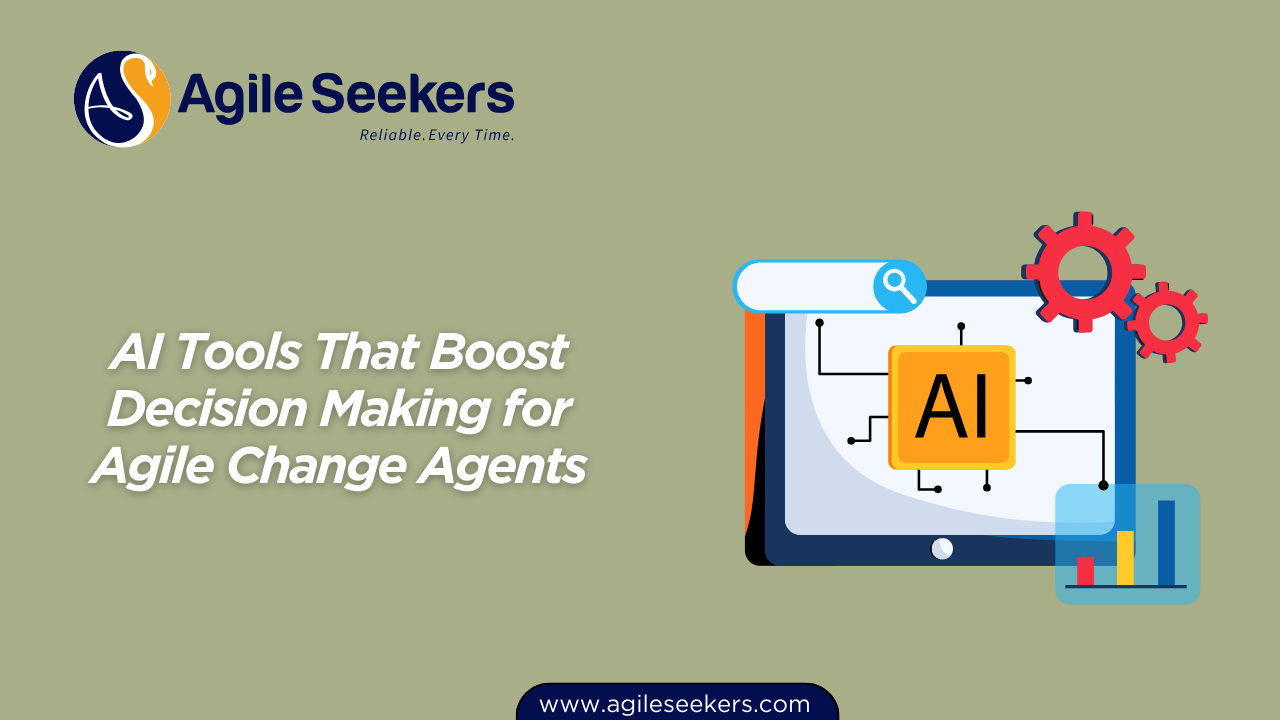AI Tools That Boost Decision Making for Agile Change Agents

Agile change agents carry a unique responsibility. They guide teams, influence leaders, and align organizations toward continuous improvement. But here’s the challenge—Agile transformations are messy. Priorities shift, dependencies multiply, and the volume of information often makes decision making harder than it should be.
This is where AI tools make a real difference. Not by replacing human judgment, but by giving change agents sharper insights, faster analysis, and stronger foresight. Let’s break down how AI is reshaping decision making for Agile professionals and which tools actually help.
Why Decision Making is Tough for Agile Change Agents
Agile change agents work across multiple layers: team, program, portfolio, and enterprise. Their job is not just about running events or teaching frameworks. It’s about helping organizations respond to change quickly while keeping business goals in sight.
The difficulties often include:
-
Data overload – Multiple tools generate metrics, but not all of them matter.
-
Conflicting priorities – Business stakeholders, product owners, and delivery teams don’t always align.
-
Risk blind spots – Dependencies or systemic risks often surface too late.
-
Emotional resistance – People-driven change is unpredictable, and decisions aren’t always data-based.
AI tools help by cutting through noise, offering predictive insights, and supporting fact-based conversations.
Key Areas Where AI Strengthens Decisions
1. Prioritization of Work
One of the toughest calls change agents face is helping leaders decide what to work on first. AI-powered backlog management tools use historical delivery patterns, cost of delay, and business value data to recommend priority order.
Instead of heated debates based on opinions, decisions are backed by real forecasts. This doesn’t remove human judgment but gives it a stronger foundation.
2. Risk Identification and Mitigation
Traditional risk registers often feel like checklists. AI enhances risk management by scanning dependencies across systems, analyzing velocity drops, and detecting anomalies in delivery flow. Tools that apply predictive analytics can flag risks weeks before they become blockers.
This is especially useful in complex programs where hidden dependencies can derail plans.
3. Change Impact Analysis
Agile transformations touch processes, structures, and culture. AI tools with natural language processing (NLP) can analyze employee feedback, survey results, or even chat data from collaboration platforms. The insights help change agents spot resistance trends early and adjust their approach.
4. Decision Dashboards for Alignment
Executive decisions need clear, visual data. AI-driven dashboards aggregate metrics from Jira, Azure DevOps, or Rally and turn them into actionable insights. Change agents can walk into leadership meetings with confidence, knowing that metrics like predictability, flow efficiency, and value delivery are not just numbers but stories backed by AI analysis.
5. Scenario Planning
What if we staff another team? What if we drop a feature? What if we delay a release? These questions often lack clear answers. AI-enabled scenario modeling allows Agile leaders to compare multiple “what-if” outcomes before making calls that impact budgets, timelines, and customer commitments.
AI Tools That Support Agile Change Agents
Here are some categories of tools that directly support decision making:
-
AI-Powered Backlog Tools: Tools like Miro AI or ClickUp AI analyze user stories and suggest priority alignment.
-
Predictive Analytics Platforms: Services such as AIOps-based delivery monitoring help anticipate delays and risks.
-
Sentiment Analysis Engines: NLP tools that analyze team morale from surveys, Slack messages, or retrospectives.
-
Value Stream Management (VSM) Tools: Platforms like Planview or Tasktop with AI capabilities show how work flows across systems and identify bottlenecks.
-
AI Dashboards: Customizable dashboards that merge delivery data, business metrics, and financials into a single view for decision makers.
The Human Side of AI-Driven Decisions
Even the smartest AI system won’t succeed without human alignment. Agile change agents still need to:
-
Facilitate conversations that balance data and intuition.
-
Help leaders interpret AI insights instead of blindly following them.
-
Ensure transparency so teams don’t feel judged by algorithms.
-
Focus on value delivery, not vanity metrics.
AI provides speed and clarity, but the human side—coaching, mentoring, and facilitation—remains the backbone of decision making.
Building Skills for the AI-Enabled Change Agent
Knowing how to use AI tools effectively requires upskilling. Agile professionals who understand both Agile frameworks and AI-powered decision tools gain an edge.
If you’re looking to expand your expertise, structured training helps. For example:
-
AI for Agile Leaders & Change Agents Certification helps leaders integrate AI-driven decision frameworks into transformation programs.
-
AI for Project Managers Certification Training focuses on predictive analytics, scenario planning, and project-level decision support.
-
AI for Product Owners Certification Training emphasizes backlog prioritization and value delivery using AI insights.
-
AI for Scrum Masters Training builds skills for using AI dashboards, team sentiment analysis, and sprint forecasting.
Each certification equips you with practical knowledge to integrate AI into day-to-day Agile work.
External Resources Worth Exploring
For those who want to dive deeper into AI and decision science, check out:
-
MIT Sloan’s research on AI and decision making for a practical lens on business adoption.
-
Harvard Business Review’s take on AI leadership, which reinforces the balance between data and human judgment.
-
Gartner insights on AI-driven analytics for a view into enterprise adoption trends.
These resources provide broader perspectives to strengthen your toolkit as an Agile change agent.
Final Thoughts
Agile change agents stand at the intersection of people, process, and strategy. Their decisions influence not just delivery, but also culture and long-term business agility. AI tools don’t take away that responsibility—they sharpen it.
From backlog prioritization to risk management, from sentiment analysis to scenario modeling, AI empowers change agents to move from reactive decisions to proactive leadership.
The takeaway is simple: change agents who embrace AI don’t just guide transformations; they accelerate them.
Also read - How Agile Roles Differ When AI Enters the Game
Also see - Measuring Agile Maturity with AI-Powered Metrics Dashboards




















